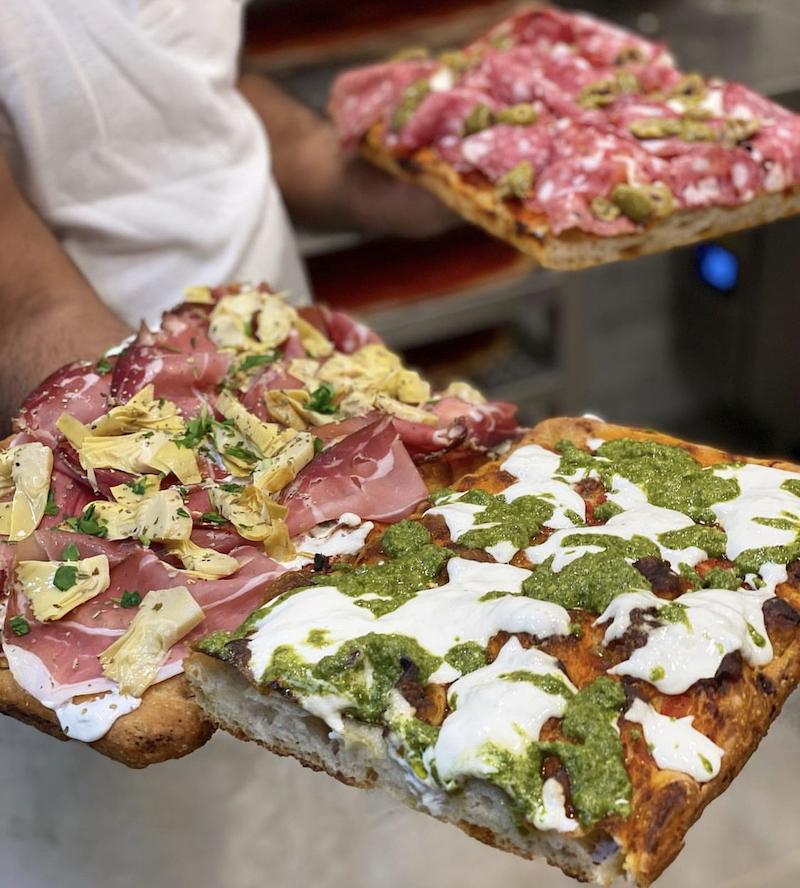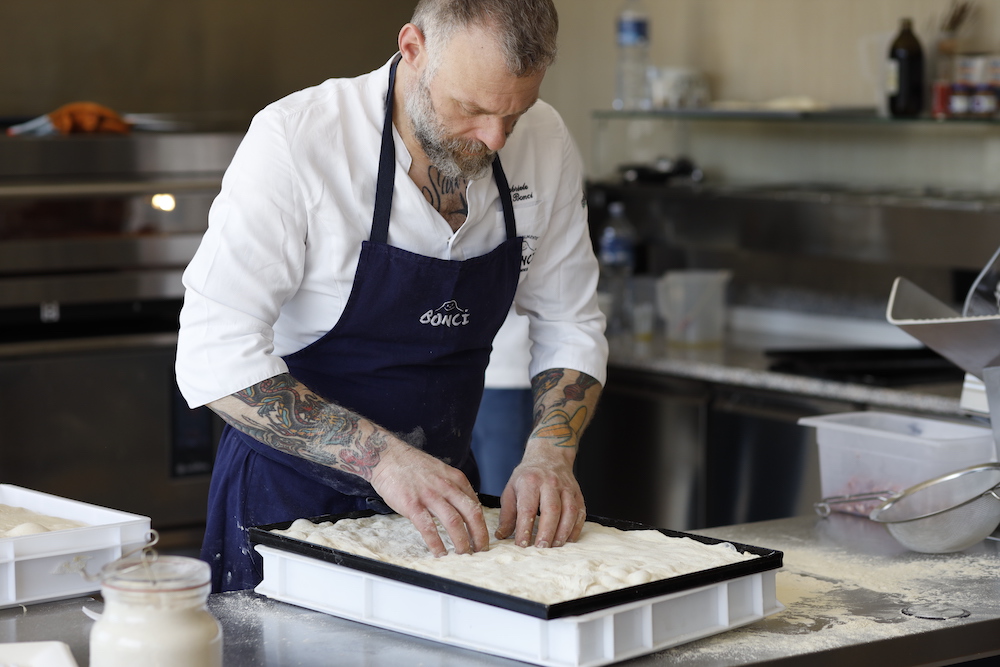- Michael Kalanty digs into authentic Roman pizzas at three exemplary shops in Rome: Bonci Pizzarium, Forno Campo de’ Fiori and Antico Forno Roscioli.
- Cut with scissors and sold by weight, Roman pizza, or pizza al taglio, is a popular and pervasive street food of the Italian capitol.
Related: Could Roman-style pizza be your next big moneymaker?
By Michael Kalanty
If Roman pizza doesn’t surprise you with its unique styles, you’re sure to raise an eyebrow when you see how it’s served: al taglio. Cut with scissors and sold by weight, pizza al taglio is a popular and pervasive street food of the Italian capitol. Also called pizza in teglia and pizza al trancio, among other titles, the name means that the vendor will cut the pie according to your desired width—use both hands to show how wide a slice you want—and determine its price using a scale (pizza alla scala).
Any pair of scissors will do the trick—in a scene from the film Cobra, Sylvester Stallone grabbed one from his kitchen utility drawer. Italian scizzo (scissors) designed specifically for cutting pizza have offset blades. This allows the lower blade to rest flush on the bottom of the pizza pan or plate while the grips are held at a 45° angle to the pie.
But just about any shape or style of pizza could be cut into slices using scissors, so the term al taglio doesn’t really tell you what to expect in terms of the pizza’s texture, thickness or baking technique. When speaking of specific styles of Roman pies, the terms pizza Romana and pizza alla pala are more descriptive.
Pizza Romana
Pizza Romana is baked in a rectangular or square metal tray. As a reference point, think of the Detroit-style pizza, with its thick and fluffy dough baked in a metal pan and its crunchy, almost fried bottom crust. When the tray is pre-lined with Parmesan or other grating cheese, the Detroit pie emerges with a crisp, lacy frame on its bottom and sides, as demonstrated by Master Pizza founder Michael LaMarca’s winning pie in the World Pizza Championship (WPC) earlier this year.
Although pizza Romana is not enshrouded in a caramelized cheese coating, it does have a noticeably crunchy bottom crust. One of the best ways to deliver that crunch is by baking it in a heavy metal pan. These pans are often made of either hard-anodized aluminum or steel for superior heat transfer, high heat capacity and even heat distribution.
A Roman-style pizza is also thinner than a Detroit-style pie. The latter can achieve heights between 1” and almost 2”, while the same pie would be half that height in Rome. To visualize, you can easily turn your Detroit-style pie into the Roman style simply by cutting the weight of the dough ball in half and baking in the same size pan. Less dough in the same volume of baking space delivers an airier, lighter texture to the Roman crust, as opposed to the slightly denser, almost focaccia style of the Detroit pie. Technically speaking, the thinner the dough, the better the thermal break between the dough and the sauce or toppings. This increases your chances for an open crumb structure and crisper bottom.
Related: Gabriele Bonci brings his Roman-style pizza to Miami

Gabriele Bonci (photo by Associazione Pizza Romana)
Bonci Pizzarium
The pizza Romana style is on full display at maestro Gabriele Bonci’s Bonci Pizzarium in Rome, located at 43 Via Della Meloria, near the Cipro metro station. Take a short walk north from the Vatican Museum, and you’ll spot hungry pizza lovers lining the street well before you actually see the storefront. Once you arrive, take a number and enjoy the people-watching.
A smiling clerk will cut your selections al taglia and then re-crisp their bottoms in a smaller service oven with the door kept open so the toppings don’t overheat. The result is a warm, toasty bottom crust with an almost al dente chew to the bread’s interior. That combo of textures is enough to make any aficionado smile. The wild array of available toppings will literally take it over the top.
Bonci offers a rotating menu of various Roman pizzas in glass cases. All pies are naturally leavened from one of Bonci’s different starters. Basic pies are baked with just olive oil and salt or spread with marinara first. A simply topped pie may have eggplant and garlic. Heartier versions are baked with toppings such as yellow potatoes and green onions, or a more ambitious pairing such as shrimp and porcini mushrooms.
There are also slightly thicker, crisper pizzas which are baked plain and then topped with salume or cured meats. My personal favorite is the prosciutto e fichi, which looks like a miniature charcuterie board, with feathered prosciutto slices, fresh figs and arugula.
Related: This Roman-style pie named the best pizza in the UK

Antico Forno Roscioli
Pizza Alla Palla
Pizza alla pala is the other style of pie that you’ll find almost everywhere in Rome. This Roman classic is baked not in a pan but directly on the oven hearth. The pizza alla pala is a thin, crispy and airy slab of dough that is “shoveled” onto the oven deck from a long wooden board (hence the “alla pala” part of the name). The pieces are cut al taglia and served on a paper plate or, depending on the number of slices, in a cardboard box.
Alla pala pizzas can be found in many Italian cities, especially Florence and Verona. Outside Rome, the pizza is characterized by a thick crust and a tender, fluffy interior, while the toppings can be anything from prosciutto and cherry tomatoes to various cheeses, olives and spicy salumi. In Rome, where the style originated, the high-hydration pizza alla pala is thin and crispy. It bears similarities both visually and texturally to some square Middle Eastern flatbreads, like the Iranian Sangak or the Persian Nan-e Barbari.
Pane alla pala is usually shaped into a rectangle with slightly rounded corners, its length determined by the depth of the oven. Because it’s baked free-form, even crispness of the bottom and side edges requires the pizzaiolo’s skill and dexterity in moving the pie once it’s in the oven. U.S. Pizza Team (USPT) member Lars Smith, co-owner of State of Mind Public House & Pizzeria in Los Altos, California, displayed his techniques in this category at the WPC earlier this year.

Fabrizio Roscioli (Photo by Forno Campo de’ Fiori)
Forno Campo de’ Fiori
Where can you taste the quintessential pizza alla pala in Rome? Head to Forno Campo de’ Fiori (Oven at the Flower Market) in Rome’s southwest corner. Boasting an oven that’s been firing since 1864, the bakery, situated on the corner of the old Roman market, boasts a pizza alla pala that is about 12” wide by 7’ long. That’s a lot of gluten to have to tame during the shaping and loading phase.
The 2-kilogram dough pieces spend approximately 30 minutes each on 8’ long canvas-covered boards that barely fit the bakery space. Before being loaded, each piece is alternately brushed with olive oil and hand-stretched at least four or five times before it’s transferred onto the hearth.
Baking the dough is a feat of pizzaiolo acrobatics that rivals the spinning airborne pies that masters like USPT member Jamie Culliton display with ease. The 8’ long board is lifted from its sawhorse support and carried to a shorter 2’ long loading peel. Holding the board at a 45° angle, the pizzaiolo simultaneously slides and pleats the dough so that it fits perfectly onto the shorter loading peel.
Recipe: Roman-style Butternut Squash Pizza
The pizzaiolo steadily draws the peel from the depths of the oven toward the front, using a series of smooth pulses to unload the pleated dough into a flat shape once again. With an oven heat of 575℉, the ¼”- to ½”-thick dough bakes to a crisp bottom and edges in seven to eight minutes.
Simply brushed with olive oil and sprinkled with salt, this so-named pizza bianca was the original street food sold at Forno Campo de’ Fiori, owned by the Roscioli family. Bianca doesn’t mean white in this case, but plain or unadorned. There is also a pizza marinara version, in which the stretched dough is slathered with red sauce just prior to baking. To get around the challenges of pleating a dough covered in sauce, the marinara version is baked in a shorter 3’ sheet.
The bianca and marinara pies are the backbone of the menu here, but there are other versions with basic toppings to round out the menu—mozzarella and tomato, cured ham and cheese, and a personal favorite: cheese, anchovies and squash blossoms. All pieces are cut al taglia and priced by weight.
The bustling market and flower stalls make for great people-watching. Pizza in hand, customers find accommodating seating on upturned produce boxes or chairs borrowed from nearby cafes (if it’s not a busy hour!), or they simply enjoy their slices while strolling the market.

Antico Forno Roscioli
Antico Forno Roscioli
Over time, evolving menu trends called for the introduction of more topping choices. Rather than changing the menu and the original style at Forno Campo de’ Fiori, the Roscioli family chose to open another spot about a two-minute walk southeast of Campo de’ Fiori, thus bookending the busy marketplace and tourist gathering spot.
Antico Forno Roscioli—located at 34 Via dei Chiavari—serves pizza alla pala with a slightly thicker crust, about ¾” to 1”, and a more open crumb. You can still get an unadorned bianca or marinara pie here, but a bigger draw is the vast assortment of toppings (some baked on the pies, others added afterwards) that Roscioli offers: cured meats, melted cheeses, fresh produce like spinach, bitter greens, mushrooms and olives. Pieces are cut al taglia and priced by weight. There are no service ovens, so the pieces are not reheated.
Antico Forno Roscioli also offers fresh-baked breads, pastries and cookies. Their Pane ai Noce is a naturally leavened hearth bread crammed with both walnuts and hazelnuts, with the almost-burnt crust that marks Roman bread-baking tradition.
If you purchase one of their loaves, make sure to walk to the end of the street and visit their cheese shop, Roscioli Salumeria con Cucina, at 21 Via dei Giubbonari. Ask for a cheese recommendation and maybe some salume to complement your bread. No respectful visitor to Rome would be without these three staples in the hotel room for late-night or early-morning snacking.
If you’re there early enough in the day (by 11:00 a.m., you might be too late!), purchase one or two of the millefoglie (flaky pastry) al cioccolato e noci—laminated yeasted dough layered with chocolate, cocoa and walnuts. If you can manage to save one for later, it goes fantastico with a caffe doppio (double espresso) and makes a great afternoon snack.
Antico Forno Roscioli fits the array of Roman pizza somewhere between the classic simplicity of Forno Campo de Fiori’s pizza bianco and Bonci Pizzarium’s more elaborate pizza Romana. Whichever one you visit, make sure to find a sweet spot to sit—one with a great view—to savor this popular street food in the authentic Roman style!
Michael Kalanty is the author of How to Bake Bread and How to Bake More Bread. He’s the former executive bread baker for Le Cordon Bleu, a network of culinary and hospitality schools, and is currently an independent product developer for the baking industry who works with Johnson & Wales University.















